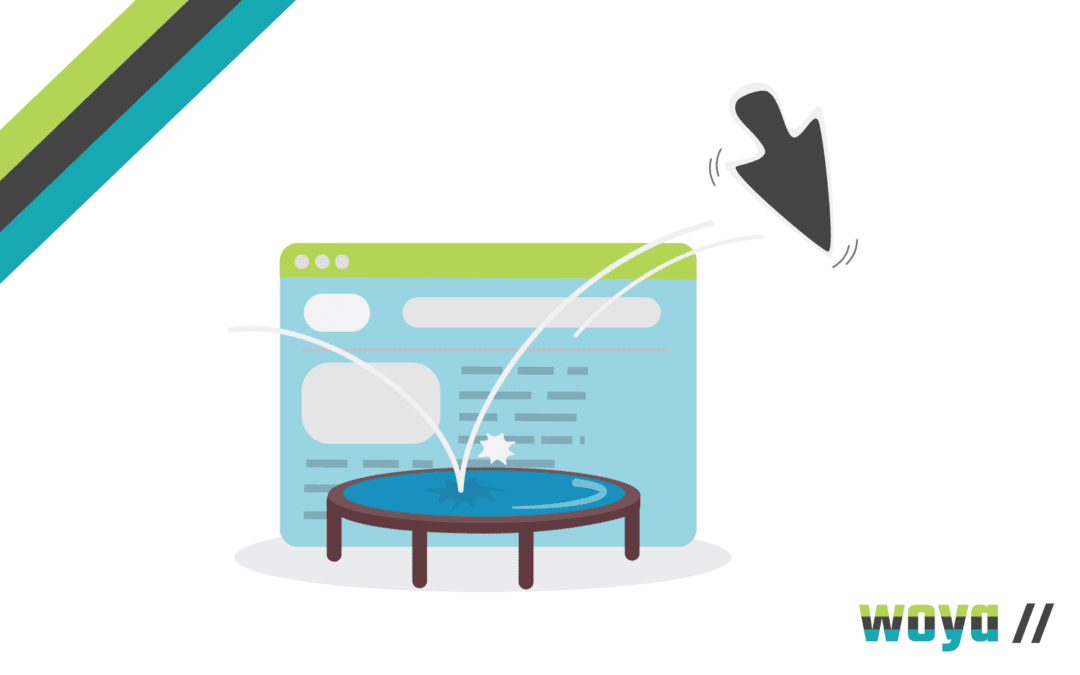SEO can seem a minefield, with a myriad of acronyms, jargon and industry terms to navigate and ever-changing goalposts of algorithm preferences, best practice protocols and software tools.
One such term amongst the many is ‘website bounce rate’. Let’s explain what it means, how important it is, and how it can be improved to boost overall SEO performance.
What is a Website Bounce Rate?
A website bounce rate is a statistic usually expressed in a percentage, and refers to the amount of users who arrive on a web page and then leave the site altogether without navigating through to another page, or taking an action on page.
Also known as a ‘single page session’, it gives an indication of the prevalence of those visiting a page, not taking any other action on the website, and leaving. This is considered a sign of the effectiveness of any given webpage on a site as, unless the desired effect for a page is solely to be read and then abandoned, its purpose is not being properly fulfilled.
What is Considered a Good Website Bounce Rate?
Website bounce rates vary hugely between industries and site types and so a perceived ‘good’ or ‘bad’ rate can be difficult to ascertain. The average website bounce rate online varies hugely, and so it’s near impossible to set a goal for a business’ online presence without some solid market research.
Website bounce rates also vary dependent on the device users are accessing the site from. Mobile devices result in an average bounce rate of 51% across all industries simply due to the brief nature of their typical usage, whereas tablets sit at around the 45% mark and desktop computers nearer 43%.
This means that it’s critical for businesses to take device usage into account, as they are more likely to have a higher website bounce rate if the majority of their users are using mobile devices. Traffic sources are also sometimes responsible for increasing website bounce rates, with visits originating from social media and paid ads often resulting in less engaged traffic.
It’s near impossible for any website bounce rate to be below 20%, as human behaviour simply can’t be accounted for, and so it’s not advisable for organisations to aim for 0%.
A bounce rate over 70% would, in most industries, be considered negative but is usually fairly easy to decrease as it’s often due to UX (User Experience) issues: such as poor design, excessive bots, browser incompatibility or tracking code errors.
How Website Bounce Rate Interacts with Other Aspects of SEO
There are many aspects to the overall discipline of SEO (Search Engine Optimisation) and so it’s worth noting that website bounce rate is just one of many factors that contribute to digital activity, presence and performance.
Technically, website bounce rate doesn’t directly influence page ranking – but it is an indirect factor. Higher bounce rates are often indicative of a UX issue that will impact on the overall performance of the site and demonstrates its usefulness to the algorithms of search engines.
How Overall Time-On-Site Affects SEO
Similar to website bounce rates, the time on-site (also known as the dwell time) is the amount of time a user spends on a web page or site before clicking elsewhere. A very low dwell time indicates that the page doesn’t meet the user’s search intent, and a longer dwell time shows genuine engagement. This metric demonstrates to search engines the authenticity, topic and overall usefulness of the website and so longer times are considered bette, but after 30 minutes of inactivity on a site, the session ends to account for untrue inflation due to windows/tabs left open unintentionally.
Website bounce rates and dwell times are different measures but both allow marketers and webmasters to understand user satisfaction and engagement with the content created.
What Bounce Rates Tell Us About a Site/Page
A website’s bounce rate can be considered a reliable informant factor of a page’s perceived value by users. Where a bounce rate is high or conversions aren’t happening where desired, new approaches can be trialled as the existing content obviously isn’t landing correctly with its audience.
One important metric to monitor is bounce rates from content that’s being linked to as a part of a paid campaign, as this can demonstrate the ROI (Return On Investment) on money spend. High bounce rates or low conversions from paid ads indicate a disconnect between the advert and the landing page and may result in wasteful expenditure unless the issue is addressed and resolved.
Website Bounce Rates Should Be Constantly Monitored
People change, attitudes change, online best practices change and website bounce rates change – and this is exactly why bounce rates need to be monitored on a continuous basis and not just as a one-off measurement of website performance.
With the algorithms behind search engines being constantly updated as well as consumer behaviours shifting, it’s not unheard of for bounce rates to ebb and flow, too. A rapidly changed website bounce rate can indicate a sudden website error or issue and so may be the first symptom of a problem that can be rectified swiftly.
Get Support With With Your Website and SEO
If you need to improve your website’s bounce rate or just need to understand where it currently sits and why, a specialist SEO company such as Woya Digital can help you comprehend things – and better your position.
Bounce rates are often easily shifted into more positive territory with a little knowhow, and with the expert team at Woya on-board, you can be sure of a move in the right direction.

